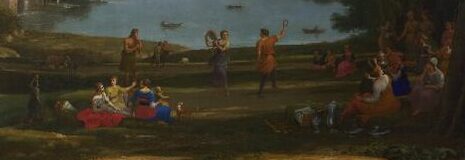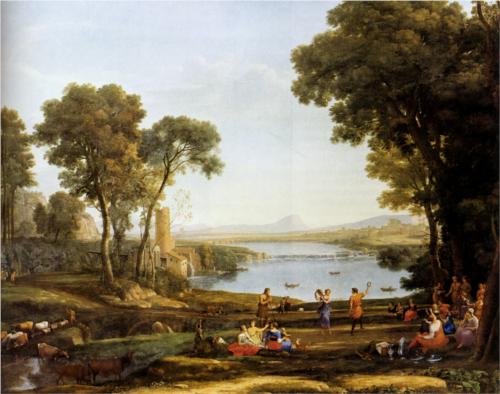Claude should have named his painting scampagnata (holiday in the country), merenda sull’erba, or lolazione sull’erba (picnic on the grass). But Claude enhanced Landscape with the Marriage of Isaac and Rebecca with a biblical allusion to Genesis, 24, the details of which are wholly his own.
If this is a wedding, it’s surprisingly informal and recreated in a contemporary Italian style portraying peasants picnicking and dancing lively to the music of a flute (recorder) and tambourines. A bride or groom is not identifiable. There is bread and wine but not what might be considered enough for a wedding feast.
Despite the tenuous link between title and subject, the painting is among Claude’s most well-known and admired compositions. Numerous artists have adapted it, the best known of which are J. M.W. Turner’s Childe Harold’s Pilgrimage–Italy (1832), an allusion to Byron’s poem, and Jean-Baptiste Camille Corot’s View Near Naples (1841), an allusion to Claude’s subject done in an impressionistic style. As with Claude, neither Turner nor Corot acknowledges the picnic’s significance.
*The artist’s name is Claude Lorrain, Claude Gellée or Le Lorrain, but the National Gallery calls him Claude. Sometimes the painting is titled The Mill because the building is partly obscure by a tree in the mid-ground; sometimes, it’s called Landscape with Dancing Figures or Landscape with Peasants Dancing. Despite the variations in the title, it is agreed that the date of composition is 1648c.
Featured Image: If this is a wedding party, where are the bride and groom?
See Claude Lorrain. Landscape with The Marriage of Isaac and Rebecca [aka The Mill] (1648). National Gallery, London; J. M.W. Turner’s Childe Harold’s Pilgrimage-Italy (1832), oil on canvas. London: Tate Britain; Jean-Baptiste Camille Corot’s View Near Naples (1841), oil on canvas. Springfield Museum of Art, Springfield, MA

